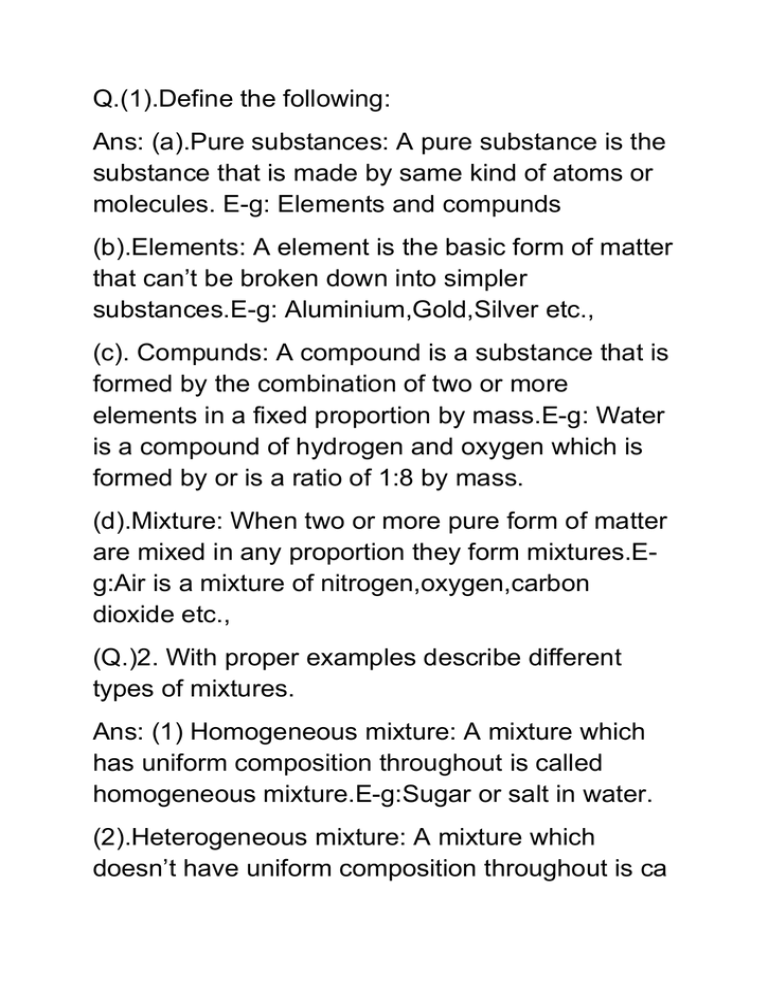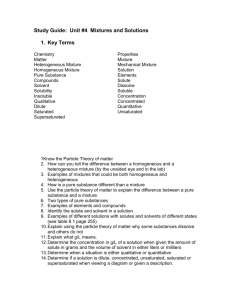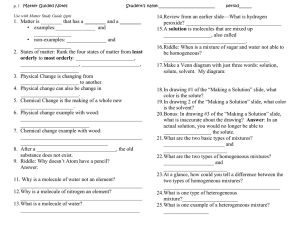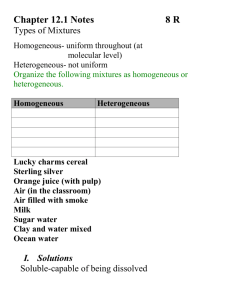Q.4. What is a solution?
advertisement

Q.(1).Define the following: Ans: (a).Pure substances: A pure substance is the substance that is made by same kind of atoms or molecules. E-g: Elements and compunds (b).Elements: A element is the basic form of matter that can’t be broken down into simpler substances.E-g: Aluminium,Gold,Silver etc., (c). Compunds: A compound is a substance that is formed by the combination of two or more elements in a fixed proportion by mass.E-g: Water is a compound of hydrogen and oxygen which is formed by or is a ratio of 1:8 by mass. (d).Mixture: When two or more pure form of matter are mixed in any proportion they form mixtures.Eg:Air is a mixture of nitrogen,oxygen,carbon dioxide etc., (Q.)2. With proper examples describe different types of mixtures. Ans: (1) Homogeneous mixture: A mixture which has uniform composition throughout is called homogeneous mixture.E-g:Sugar or salt in water. (2).Heterogeneous mixture: A mixture which doesn’t have uniform composition throughout is ca lled heterogeneous mixture.E-g:Oil or sand in water. Q.3. Differentiate between mixture and compounds. Ans: Pg.No: 26. Q.4. What is a solution? Ans: A solution is a homogeneous mixture of two or more substances. Q.5. What are the components of a solution? Ans: A solution has a solvent and a solute as its components.The component which is dissolved in the solvent is solute.The component of the solution that dissolves the other component in it, is called solvent. Q.6.What are the properties of a solution? Ans.1.A solution is a homogeneous mixture. 2. The particles of a solution are smaller than nanometer(i.e 10−9 m) in diameter).So they cannot be seen by naked eyes. 3.Due to very small particles size,they don’t scatter a beam of light passing through the solution.So the path of light is not visible in a solution. 4. The solute particles cannot be separated from the mixture by the process of fitration. Q.7.Explain the classification of solution on the basis of the physical states of the solute and solvent. Ans: solutions Examples Solid in solid Brass and bronze Solid in liquid Sugar in water Solid in gas air,smog,smoke Dust particles in Liquid in solid cheese,butter Liquid in liquid Alcohol in water Liquid in gas Moisture in water Gas in solid Hydrogen in palladium Gas in liquid Aerated water Gas in gas Air Q.8.What is saturated solition? Ans: When no more solute can be dissolved in a solution, at a given temperature, it is called a saturated solution. Q.9.What is solubility? Ans: The amount of solute present in a saturated solution at a given temperature is called solubility. Q.10.What is the concentration of a solution? Ans : The concentration of a solution is the amount of solute present in a given amount of solution or the amount of solute dissolved in a given mass or volume of solvent. Therefore the concentration of a solution = Amount of solute Amount of solution Q.11.Define unsaturated solution. Ans: If the amount of solute contained in a solution is less than the saturation level,it is called unsaturated solution. Q.12.Mention two ways to express the concentration of a solution. Ans:







